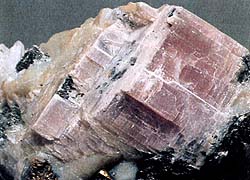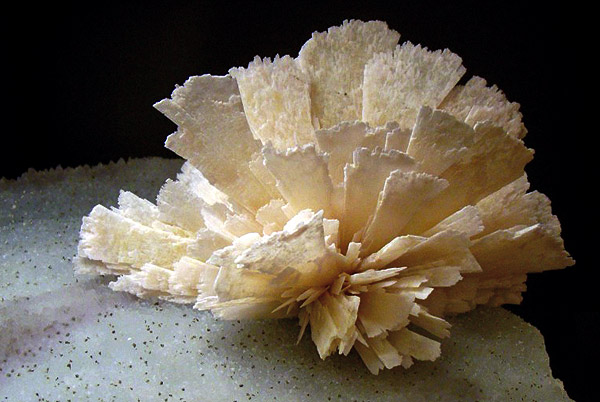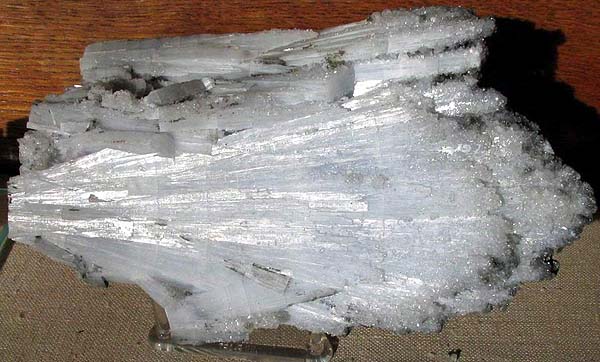Sulfates: Anhydrite
 Diagnostic Card.
Diagnostic Card.
Photo: aggregate tabular crystals of Brosseau. Below: The white crystals of anhydrite to gypsum colorless.
Ca SO 4
Stingoniya rhombic
Hardness 3-3.5
The share of 2,98-3
Cleavage is perfect
The break in the wrong
Colour colorless (painting changeable)
Color white powder
Shine from glass to pearl

Anhydrite (Greek "dry"). The name refers to the mineral and it consists of rock. Calcium sulfate. Luster pearly to the glass. Sometimes transparent and opaque. Colours: white, gray, bluish, red; sometimes colorless. The bar is white. Fracture splintery. Fragile. Cleavage is perfect. Is formed together with rock salt and gypsum. Crystals (orthorhombic system) are rare, remind cubes; mostly fine-grained anhydrite composes dense masses or fibrous aggregates. Distribution Region: Lower Saxony (Germany), Harz (Germany and Germany), Switzerland, Austria, England, Chile.
 Individual crystals of anhydrite with clear forms do not occur very often. They are characterized by the appearance of short plates or prisms, sometimes complicated by numerous facets. More common in massive clusters of dense granular, fibrous or tonkoplastinchatogo structure having large sizes for him. Painting anhydrite, usually white or gray, but can be reddish. Especially prized beautiful purple hue inherent in some instances. The powder is always white. Anhydrite translucent or transparent. Luster - from glass to pearl, medium or low hardness; it is quite heavy, kink - wrong.
Individual crystals of anhydrite with clear forms do not occur very often. They are characterized by the appearance of short plates or prisms, sometimes complicated by numerous facets. More common in massive clusters of dense granular, fibrous or tonkoplastinchatogo structure having large sizes for him. Painting anhydrite, usually white or gray, but can be reddish. Especially prized beautiful purple hue inherent in some instances. The powder is always white. Anhydrite translucent or transparent. Luster - from glass to pearl, medium or low hardness; it is quite heavy, kink - wrong.
Chemical composition. Calcium Oxide (CaO) 41.2% sulfur trioxide (S03) 58,8%, as an impurity often found strontium. Gloss. Glass, bold, pearl effect on the cleavage planes. Form crystalline precipitates. Tolstotablitchatye, cubic, short-columnar crystals; mostly anhydrite forms a solid mass.
The crystal structure. sulfur ions (S6 +) are located in the center of the tetrahedral groups of oxygen (O2), and each of calcium ion (Ca2 +) is surrounded at eightfold oxygen ions. Class symmetry. Rombo-bipyramidal - mmm. Cleavage. Perfect for (001) (010) (100). Aggregates. Dense, granular, sometimes shpatovidnye, fibrous.
Diagnostic features.
For anhydrite characterized by perfect cleavage in three mutually perpendicular directions of the prism. It creates the impression that the image blocks; faces actually have the shape of a rhombus. Anhydrite is soluble in hydrochloric acid and water, although the latter is not so easy. Under the action of the atmospheric agents sulphate absorbs water and is converted to gypsum, and its initial volume increases by about 1.6 times. Do not melt. The powder is dissolved in H2SO4. The water dissolves very poorly in hydrochloric acid does not decompose. The powder is dissolved in sulfuric acid. By adding water turns into gypsum.
Origin.
Anhydrite together with gypsum and other minerals found in salt-bearing strata of sedimentary rocks of different geological eras. Formed by the evaporation of salt water in a hot climate. In some cases, it may be formed in dehydration of gypsum. Finally, more rarely, it is formed in the cavities of volcanic rocks and in ore-bearing veins. Widely distributed as a rock-forming mineral, a frequent companion of gypsum and dolomite deposits of salts.

Anhydrite brush on quartz. Brazil. (2011).
Place of Birth.
In Italy, this mineral is common and forms large column of dense massive clusters or saccharoidal addition, especially in Costa Volpino about Lovere, near Bergamasco. The ore veins in the mine Brosseau, near Ivrea (province of Turin) discovered rare crystals and shpatovidnye mass of purple-gray color. Magnificent anhydrite samples found in the mine Kampiano about Bokked-zhyano (Province of Grosseto). Quite exceptional violet crystals up to 15 cm have been found during the construction of Lenin Simplon tunnel in the Alps. Outside Italy anhydrite occurs as shpatovidnyh masses, as well as crystals in the salt deposits Beke (Vaud, Switzerland), in the Hall fields near Innsbruck Aussee in Styria province Ischl near Salzburg (Austria), Wieliczka (Poland) and others locations in Europe and beyond.
Application.
Anhydrite is used in the paper industry and in the production of sulfuric acid.

Anhydrite. Nike, Chihuahua, Mexico. The splice blue crystals poorly digested. About 15 cm Photo:. © AA Evseev.
- Gatchell - "New Almadén snag" - arsenide and antimony sulfide (modern sulphosalts)
- Antimony - toxic metal (semi-metal) are widely used in industry, medicine and engineering
- Zirconium - a rare and non- metal and dangerous jewel in the oxide and salts
- Gold - yellow dangerous and toxic metal -date and accurate digital cable technology
- Sulphur - a golden-yellow toxic substance and a sign of volcanic activity
- Cadmium - a toxic uncirculated unknown wide range of people silvery metal
- Lead - a poisonous gray simulator silver metal and toxic metal snag
- Arsenic - poison classic medieval and modern poisoners and medicine in medicine
Toxic and hazardous radioactive rocks and minerals
** - Poisonous stones and minerals (obligatory check in chemical laboratory + clear indication of toxicity)
** - Radioactive rocks and minerals (obligatory check on a regular dosimeter + ban on the open sale of radioactivity in the event of more than 24 mR / hour + additional measures to protect the population)
Catalog minerals and gems in groups of the world
** - Poisonous stones and minerals
** - Radioactive rocks and minerals


Comments
Commenting, keep in mind that the content and the tone of your messages can hurt the feelings of real people, show respect and tolerance to his interlocutors, even if you do not share their opinion, your behavior in terms of freedom of speech and anonymity offered by the Internet, is changing not only virtual, but real world. All comments are hidden from the index, spam control.